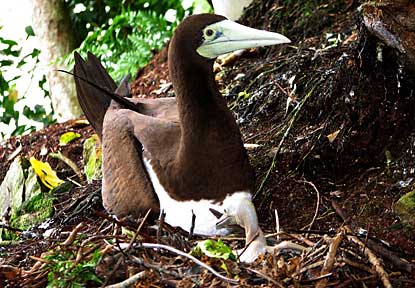 |
 | |
  | |
|
|
|
|
National Park of American Samoa
Nature & Science
|
|
|
|
|
| |
 |

|
| NPS photo by Tavita Togia. |
| Brown booby, fua'o, nest on Pola Ridge. |
|
Overview
The Samoan Archipelago is a typical Pacific Ocean Volcanic Island arc. As the Pacific Ocean plate moves across a stationary hot spot (a place where molten rock from the Earth's mantle pierces the lithosphere plate) it forms a line of volcanoes, some of which reach the ocean surface to form a string of islands. The National Park of American Samoa is really 'three parks' on four separate islands--Ta'u, Ofu/Olosega, and Tutuila. American Samoa National Park is undeveloped and remote--in the Southern hemisphere and near the International Date Line and (from America) in the far Pacific. These web pages offer you an opportunity to visit the park vicariously--and appreciate the park's unique culture, biodiversity and scenic beauty, and day-dream of actually visiting Ofu, Olosega, Ta'u, and Tutuila. Plan to spend some time here someday.
|
|  |  |
|
|

Natural History Guide to the Park
The on-line version of our latest book
more... | | 
Fish Inventory
Lots of pictures of our local fishes
more... | | 
Coral Inventory
More than 200 species, many illustrated
more... | | 
Plant Inventory
Checklist of higher plants with some illustrations
more... | |
|
|
|
|
|
|
|
 |
|
Did You Know?
Throughout the Pacific the main reason for the rarity of the two fruit bat species, or flying foxes, is that it is widely sought as a food and considered a delicacy. Sale or trade in fruit bats is now illegal in the U.S. and its territories.
|
|
|
|
Last Updated: January 29, 2008 at 13:44 EST |






